When it comes to slot games, players often become captivated by the shimmering lights, intriguing themes, and the adrenaline of turning the reels. But beyond the sparkle and excitement lies an important concept that every player should understand: Return to Player, or RTP. This key metric plays a significant role in deciding the return of your wagered money over time, influencing your gaming experience and strategy as you play.
RTP is commonly stated in percentage terms and represents the average amount of money returned to players compared to the overall stakes. For instance, if a slot game has an RTP of 95%, it means that, on average terms, players can expect to get back 95 dollars for every $100 they stake. win55 Đăng nhập Understanding this concept can help players make informed decisions when selecting slots to enjoy, ultimately improving their overall casino experience.
What exactly the meaning of RTP?
Return to Player, commonly referred to as RTP, is a crucial factor in the realm of casino slots games. It indicates the proportion of total wagered amounts that a specific slot is set to pay back to players in the long run. For example, if a slot has an RTP of 95%, this means that, in theory, players can expect to receive back 95 dollars for every 100 dollars wagered in the long run. Understanding RTP helps players assess the likely returns of the various slots available.
RTP isn’t a surety of specific victories but instead it is an average determined over many spins. Individual players’ experience might be different significantly as a result of the randomness built-in in slot machines. A greater RTP suggests superior odds for the player, which makes it a key aspect to think about when selecting the slots to play. Still, despite having high RTP, there can be stretches in which players face losses, since randomness plays a significant role. win55 Casino
It should also be noted that various slots have different RTP percentages. Some games might feature a reduced RTP as a result of a considerable fun or distinct elements, while others maintain a elevated percentage to attract more risk-averse players. Comprehending RTP empowers players to make wise choices about their gambling strategies and manage their money efficiently while relishing the adrenaline of slot machines.
The Way Return to Player is Being Determined

A RTP, or Return to Player, represents a critical metric in the world of gambling slot machine titles. This denotes the proportion from total bet funds that a slot machine can be expected to pay back to players in the long run. Understanding how this measurement is derived requires understanding of both the slot’s architecture and its payout structure. This return value is calculated via complex algorithms as well as data evaluation executed in the course of the game development phase. Game creators take into account various elements, which include the frequency of successful outcomes and the amount of payouts for every combination.
To compute RTP, developers simulate a vast quantity of rotations of the game. These simulations help determine how much on average, a player is likely to earn according to their bets. For example, if a machine boasts an RTP of 95%, this means that, in theory, for every $100 bet, gamblers can expect to get ninety-five bucks back over time. That figure doesn’t represent how much a gambler might receive in a one play and over a couple of plays; instead, it shows overall return projections.
RTP values are usually disclosed from the casino and slot creator. Players must always seek out this data while selecting a casino slots, as it can significantly affect their overall enjoyment. A higher return value usually indicates a better probability of winning back a portion of wagered money, although individual sessions may differ considerably. Grasping this concept enables players make informed decisions while improve their overall enjoyment in the world of casino slots.
Importance of RTP in Gaming
Comprehending the Return to Player or Return to Player is essential for any gamer involved in gambling on slots. RTP is the proportion of total bets that a game is designed to pay back to gamers over the long run. A greater Return to Player shows that gamers can look forward to receiving a bigger share of their bets back, making it an significant factor for those looking to enhance their gaming experience. Knowing this number aids players make informed decisions about which slots to play, as it can significantly influence their potential winnings.
Additionally, RTP plays a crucial role in the overall equity and transparency of casino slots. Players are often drawn to games with greater RTP percentages because they provide a superior chance of success over the long term. Casinos and game developers use Return to Player as a selling point to attract gamers, ensuring they maintain a lead in the growing gambling industry. By understanding of RTP, gamers can choose games that match with their risk tolerance and gaming goals.
In conclusion, the idea of RTP promotes responsible gaming practices. Recognizing that not all slots will provide immediate returns and that Return to Player is based on extended play, gamers can manage their anticipations and playing habits effectively. This understanding enhances the enjoyment of casino slots while fostering a more balanced gambling landscape. Gamers who grasp the importance of Return to Player are likely to have a better experience and lessen the risks of gambling issues.
